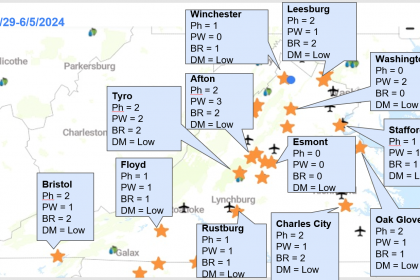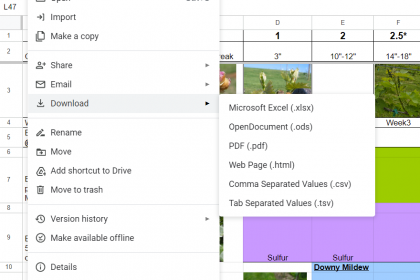I hope you are enjoying the much-needed rains in your area. It seems a bit early to talk about bloom, but vines are moving much quicker than I anticipated, probably due to the warm April.

Bloom begins a critical period for cluster infections by downy mildew, powdery mildew, black rot, Botrytis, and ripe rot, as the pathogens responsible for these diseases can infect flower parts. Symptoms may appear shortly after infection for downy and powdery mildew or closer to harvest time for Botrytis and ripe rot.
I recommend applying protective materials to shield the tissues for 4-6 weeks for V. vinifera varieties and 3-4 weeks for V. labrusca varieties. This translates to approximately 3-4 sprays for V. vinifera and 2-3 sprays for V. labrusca. For hybrids, they typically fall in between, requiring about 4-5 weeks of protection. As always, ensure that you rotate the modes of action by using different FRAC (Fungicide Resistance Action Committee) groups.
Below is a list of materials for each disease. Please consider your specific circumstances, including the site, cultivar, disease history, recent weather, and upcoming weather forecasts, before making your decisions. In general, it is more effective, cost-efficient, and better for the environment to protect your vines rather than try to recover diseased ones. Do not wait until you observe signs of disease!
Powdery Mildew: Sulfur (FRAC M2) is a cost-effective option for preventing powdery mildew. While copper (FRAC M1) is also effective against powdery mildew, my experience shows that the copper formulation I used was slightly less effective than sulfur. Other materials that can be used to combat powdery mildew include:
- – DMI fungicides (e.g., Rally, Elite, Mettle, Rhyme, Ceyva, etc.; FRAC 3)
- – Quintec (FRAC 13)
- – Vivando (FRAC 50)
- – Luna Experience (FRAC 7 + 3)
- – Topguard EQ (FRAC 11 + 3)
- – Aprovia (FRAC 7)
- – Aprovia Top (FRAC 7 + 3)
- – Miravis Prime (FRAC 7 + 12)
- – Torino (FRAC U6)
When using these fungicides, please remember to rotate FRAC codes. It’s advisable to limit the use of a particular FRAC code to twice per season, except for those beginning with the letter “M.” It would be a great idea to mix a powdery mildew material with either sulfur or copper.
Unfortunately, in Virginia, there is widespread resistance to QoI fungicides (FRAC 11, e.g., Abound, Flint) among powdery mildew isolates, so I would not rely on QoI materials for effective powdery mildew management.
Suppose you’ve experienced a powdery mildew outbreak in the past few years and are concerned about it. In that case, we have had success with pre-bloom applications of a combination of SDHI and DMI fungicides (i.e., use synthetic materials before bloom).
Downy Mildew: Protective materials for managing downy mildew include: Mancozeb (FRAC M3) [Gavel, which contains mancozeb + zoxamide (FRAC 22)], Captan (FRAC M4), fixed copper (FRAC M1), Revus or Forum (FRAC 40), Zampro (FRAC 40 + 45), and Ranman (FRAC 21).
Important Note: There are increasing cases of Revus-resistant downy mildew isolates in Virginia. Additionally, resistance to Ranman has been observed among downy mildew pathogens affecting other crops. Ensure you spray before rain and rotate the FRAC codes to manage resistance effectively!
Black rot: The protective materials for managing black rot include Mancozeb, QoI fungicides (FRAC 11, such as Abound, Flint, Pristine, Intuity, etc.), and DMI fungicides (FRAC 3, like tebuconazole, Elite, Rally, Rhyme, etc.). Please note that captan and copper treatments are ineffective against black rot. Additionally, there are concerns about fungicide resistance with FRAC 3 materials in New York. While I haven’t observed this trend in my vineyard, if you feel that your DMI products are not effectively controlling black rot, please reach out to me.
Kick-back Materials for Downy Mildew and Black Rot: Several materials exhibit kick-back activity against downy mildew and black rot. These include Ridomil products (FRAC 4), phosphonate products (FRAC P07, such as Prophyt and Phostrol, aka phos acids), and myclobutanil (FRAC 3, DMI) for black rot. These materials can be effective if applied between the time of infection and the establishment of the pathogen. It is crucial to spray within 3-4 days after rainfall (i.e., after the rain, but before you see symptoms).
Currently, we do not have any eradicants that can eliminate already established pathogens. It is important to note that infection can occur very quickly on flowers and young fruits. Therefore, instead of solely relying on kick-back action, it is advisable to protect the vines proactively.
Botrytis: The development of Botrytis is influenced by the types of grape varieties you grow and your canopy management strategies. White-fruited varieties with tight cluster architectures tend to be more susceptible to Botrytis. In contrast, red-fruited varieties with looser clusters typically experience fewer issues with this fungus, especially when the canopy is well maintained. Since the Botrytis pathogen thrives in high humidity, a poorly managed canopy that traps moisture can exacerbate the problem.
Bloom time is crucial for managing Botrytis, as this fungus can infect flowers and their debris, with symptoms appearing later as the berries mature. There are various materials available for controlling Botrytis, including Rovral and Meteor (FRAC 2), Elevate (FRAC 17), Vanguard and Scala (FRAC 9), Luna Experience (FRAC 7+3), Kenja (FRAC 7), Miravis Prime (FRAC 7 + 12), and Switch (FRAC 9 + 12). Please mix one of these materials with either captan or copper to reduce the risk of fungicide resistance development. It’s important to note that, similar to powdery mildew, QoI fungicides are no longer the most effective option for us due to the emergence of QoI-resistant Botrytis strains throughout Virginia.
Ripe Rot: Currently, the following fungicides are recommended for managing ripe rot: mancozeb, ziram (FRAC M3), captan (FRAC M4), Aprovia (FRAC 7), Switch (FRAC 9 + 12), Rovral (FRAC 2), and QoI (Strobilurin, FRAC 11). Please note that mancozeb and Aprovia have 66-day and 42-day pre-harvest intervals (PHI), respectively, which may limit your ability to spray them later in the season. Also, a survey conducted by our lab found numerous cases of QoI-resistant isolates. Moreover, it’s essential to understand that no single product provides adequate control.
To effectively manage ripe rot, consider rotating modes of action and using a tank mix that combines at least two different modes of action. The timings for fungicide application are as follows: during bloom, veraison, and two weeks after veraison. If you have grape cultivars that will remain on the vines for an extended period after veraison, it’s advisable to apply an additional spray.
I am looking forward to seeing you at our monthly Virtual Viticulture meeting this Thursday (5/8) at 1 p.m.






This Post Has 2 Comments